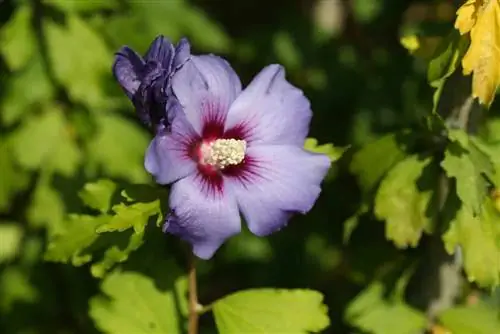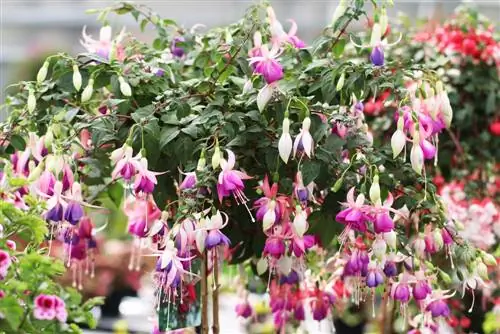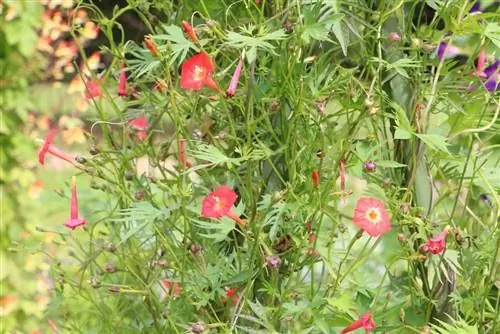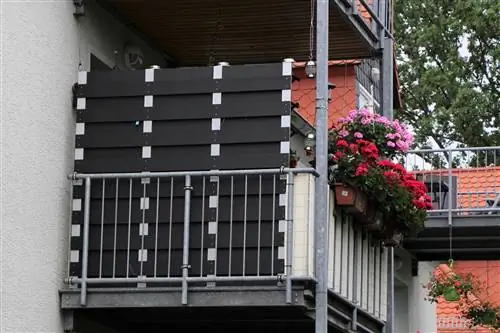- Author admin [email protected].
- Public 2023-12-17 03:39.
- Last modified 2025-01-24 12:45.
You don't necessarily have to travel far away to enjoy a little Mediterranean flair
Sowing Mediterranean plants
Sowing depends on the respective plant species. Warm to hot temperatures are the basic requirement for a good start to growth for almost all Mediterranean plants. While olive trees can survive with little water even at very high temperatures, Mediterranean plants such as the fig tree require sufficient moisture. A warm place can be chosen for sowing, which makes regular watering easy and provides constant conditions for he althy growth.
Repotting
When choosing the location, you can choose a transitional location, such as a pot, a bucket or an outdoor space. If the temperatures are already so warm that growth is favored by the natural climate, the final location should ideally be chosen. If you choose a pot, repotting should be done early on. If Mediterranean plants are subject to optimal growth conditions, repotting may become necessary more quickly than with regional plants. Heat and humidity can be real propellants that help Mediterranean plants, such as Mediterranean cypress, to grow quickly.
Location, watering, fertilizing
Watering should always be done on average. Even though Mediterranean plants thrive in extreme environments, extreme water or sun positions are rather unfortunate location conditions. Regular watering and a good location right from the start enable the desired Mediterranean plant to grow safely. You should be particularly careful with fertilizers for Mediterranean plants. Due to the often low requirements, a fertilizer with too many nutrients can be overkill and over-fertilize the Mediterranean plant.
Regular assessment of the growth progress and a look at the amount of water, if necessary, a change of location replaces many fertilizer ambitions. Ideally, choose the time of sowing according to the ongoing temperatures and be as close as possible to the original location of the respective Mediterranean plant. Support he althy and long-lasting growth and enable the growth of a strong and fruit-bearing Mediterranean plant right from the start.
Cutting Mediterranean plants
Helps cutting branches or stems to give the shoots space and the plant sufficient strength, inexperienced cutting can lead to the death of the Mediterranean plant. It is therefore important to look at the individual requirements of each plant and do justice to them. With Mediterranean plants the rule applies: let them grow first and only cut them in rare cases. The withered flowers of the hibiscus should be removed immediately after they are noticed in order to provide space and enough sunlight for the upcoming flowers. Cutting a thyme or rosemary should be carried out with caution. Towards winter, shoots grow on the branches that can easily be viewed as dead. If you cut off these ends, it has a negative effect on the plant and can lead to immediate death.
Wintering
Many Mediterranean plants are not familiar with German winter conditions. To ensure that they survive the winter well below 10 °C, it is advisable to change the location of the plants early. If they are in pots or buckets, they can be transported to a slightly heated winter garden, shed or cellar. When changing the location, ensuring brightness and the influence of the sun must always be taken into account. If the Mediterranean plants are transplanted into the ground, air-permeable tarpaulins will help.
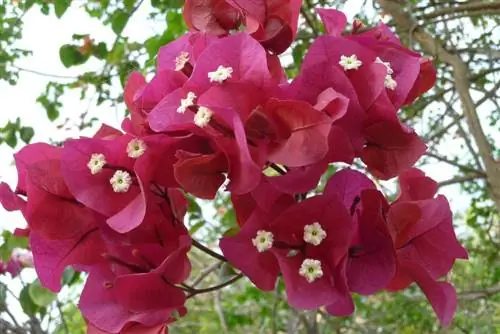
Heating boilers can provide a few higher temperatures during very cold winters and increase the likelihood of safety. If a harsh winter with lightning ice and ground frost is expected, don't wait too long and protect your plants, if necessary by digging them up over a large area and transporting them to a warmer location. Especially with plants that you have had with you for a year or longer, do not take any risks and ensure early, extensive winter protection.
Propagate, diseases and pests
A particular advantage of Mediterranean plants is that shoots and sprouts are easy to plant and grow. Become your own little school of Mediterranean plants and grow real jasmine, hemp palm or the long-flowering oleander in as many quantities as you like. Unfortunately, the pests that are spreading in Germany are also pests for Mediterranean plants. If you notice aphids on the leaves of your evergreen magnolia or lemon tree, don't wait long and first use a natural antidote to rid your plant of the infestation. Mediterranean plants are generally less susceptible to pests and are more sensitive to temperatures and too much or too little watering. The most important thing is continuity in heat and water supply.
Popular Mediterranean plants
- Kaki
- Love Tree
- Laurel
- Bird of Paradise Flower
- Triplet Flower
- real jasmine
- Strawberry tree
- Elephant foot
- Angel Trumpet
- Pomegranate
Before purchasing, find out about the individual needs of each plant and consider the characteristics of your location: Do you have a lot of space to offer? Is the space consistently supplied with sunlight? Can plants develop in width and height or is repotting or moving necessary? Do you want to plant plants with fruits or plants with flowers? How much time do you want to invest in raising and caring for them? The more detailed you can answer the questions for yourself, the better your plants will grow. Failures can be avoided from the start and you can enjoy the beauty of the south in your garden or on your balcony in summer or late summer!
Other popular Mediterranean plants
- Olive tree
- Mediterranean Cypress
- long-flowering oleander
- Hemp palm
- Date palm
- Lemon tree
- Fig tree
- Hibiscus
- Grapevine
- Mulberry tree
What you should know in brief
You don't necessarily have to travel far away to enjoy a little Mediterranean flair. You can easily bring Tuscany, Andalusia, Mykonos or Provence home to your balcony, terrace, garden or even a courtyard.
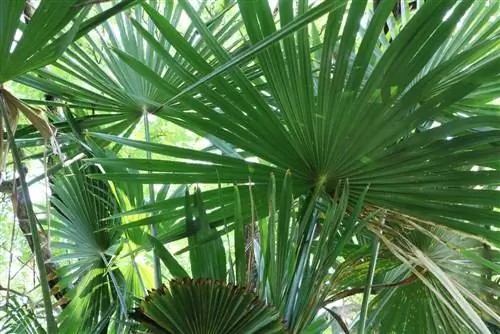
Andalusian ambience can be created with potted plants and lush floral decorations in simple containers: In Andalusia, many passionate pot gardeners transform their courtyard into a flower paradise. Not only are there lots of potted flowers on the floor, the lime-white walls are also decorated with geranium pots. Plants such as bougainvillea, oleander, hibiscus, myrtle, jasmine, palm lily, quaking grass, lantana, mallows, climbing roses, verbena, boxwood, laurel, olive trees, figs, leadwort or pomegranate give us the atmosphere we need. Of course, everything in true style in terracotta pots.
- Citrus plants pamper us not only with their flowers, but also with their scents: lemon, tangerine and orange trees, grapefruit, grapefruit and bergamot.
- Wine and wisteria are also an inseparable part of the southern flair. In large pots, they create a holiday atmosphere on even the smallest south-facing balconies and provide us with the shade we need.
- Spicy herbs such as lemon balm, sage, thyme, basil, oregano, coriander, rosemary and of course lavender - most beautiful in very light clay pots - delight our senses and lift our mood.
- Add to that stylish garden furniture, a palm tree in a pot, terracotta in all variations, a few stone figures, pretty accessories and a romantic lantern - and we have arrived in the sunny south.
- When it comes to palm trees, date palms (Phoenix canariensis), hemp palms (Trachycarpus fortunei), Madagascar palms (Pachypodium lamerei), dwarf date palms (Phoenix roebelenii) and others are impressive.
Recently, more and more exotic plants have been added to citrus plants. Countless fruit trees are on offer. Many of them look great on the terrace or in the garden in the summer, but they lack appropriate wintering quarters. That's why many of these exotic animals survive the winter poorly. Figs, e.g. Ficus carica 'Bornholmfigen', are very Mediterranean and quite easy to cultivate. A hardy fig is Ficus 'Brown turkey'. Ficus 'carica' (green and blue) can tolerate temperatures down to -20 °C. Sharon fruit (kaki fruit), real pomegranate, Nashi pear, prickly pear, strawberry tree, goji berry and others are also very popular in the bucket.
Cranberries are not only he althy, you can also grow them in the garden. They are ideal ground cover plants. However, you have to be careful in autumn when the berries ripen. They taste great to birds and they are quick to harvest.
Typical Mediterranean plants are also
- Palisade wood tree (Jacaranda mimosifolia), with its great blue-purple flowers
- Eucalytus (Eucalyptus gunnii) with its blue-gray foliage
- Orange jasmine (Murraya paniculata) with its numerous white flowers
- Hawaiian palm (Brighamia insignis) with its yellow flowers
- Passion flowers of all kinds (Passiflora caerulea) with their different colored flowers
- Cypress trees (Cupressus sempervirens), which impress with their extraordinary growth
- True laurel (Laurus nobilis), whose leaves can be used in the kitchen
- Love lily (Agapanthus africanu s) with its great white or blue flowers
- Temple trees (Blumeria) with their fragrant and beautiful flowers
- Oleander fig (Ficus alii) with its striking growth
- Judas tree (Cercis seliquastrum) with its flowers growing directly from the trunk
- but also the normal boxwood (Buxus), which fits everywhere and is evergreen.
You can get countless Mediterranean plants in stores. One should never forget that many of them cannot cope with our Central European climate. They can only be cultivated in containers. Even if the name boards say that the plants can withstand temperatures down to -20 °C, you can't rely on that. It always depends on which climate zone you live in. It may be that the plants survive a cold night well, but permanent frost kills almost all of them. That's why you have to overwinter the pots in the house, garage or similar or pack the pots very well outside, if possible with heating. In areas with mild winters, such as wine-growing regions, many Mediterranean plants survive the winters outside quite well. But very few people can cope without protection.

